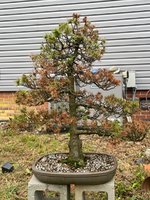bwaynef
Masterpiece
I don’t know how well the title translates outside of the south but the picture probably makes it make sense.
This tree recently came to me to see if it can recover in my yard. I have low hopes for it. The green parts have new growth on the ends.
In mid-April-ish it was repotted into equal parts Lava, Akadama, and Pumice out of if I’m remembering correctly straight akadama. I wasn’t there when it was repotted but I have my suspicions that more roots than necessary were removed, likely because of the soil change. It also isn’t completely stable in the pot. It doesn’t flop around but will move if you’re purposeful about checking whether it will.
It’s been treated with Talstar in case of pests, Daconil in case of fungus, and imidacloprid for any other pests.
The soil drains pretty quickly now but I’ve propped the pot in hopes of making sure the soil dries as quickly as possible. I’ve heard jwp are often handled with scary amounts of water. (Or scary amounts of not-water may be a better way of saying it.)
It’s situated where it gets shade about 2-3p.
It’s hard to sit by and watch but I don’t think there’s anything I can do to give it a better chance. Do you have any other ideas?
This tree recently came to me to see if it can recover in my yard. I have low hopes for it. The green parts have new growth on the ends.
In mid-April-ish it was repotted into equal parts Lava, Akadama, and Pumice out of if I’m remembering correctly straight akadama. I wasn’t there when it was repotted but I have my suspicions that more roots than necessary were removed, likely because of the soil change. It also isn’t completely stable in the pot. It doesn’t flop around but will move if you’re purposeful about checking whether it will.
It’s been treated with Talstar in case of pests, Daconil in case of fungus, and imidacloprid for any other pests.
The soil drains pretty quickly now but I’ve propped the pot in hopes of making sure the soil dries as quickly as possible. I’ve heard jwp are often handled with scary amounts of water. (Or scary amounts of not-water may be a better way of saying it.)
It’s situated where it gets shade about 2-3p.
It’s hard to sit by and watch but I don’t think there’s anything I can do to give it a better chance. Do you have any other ideas?



